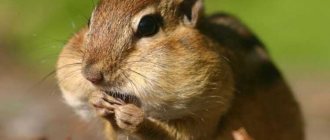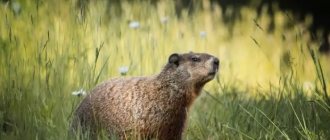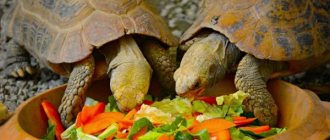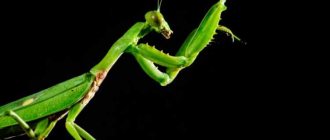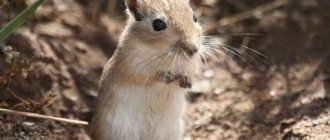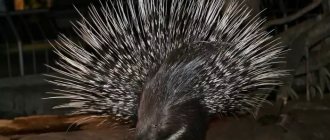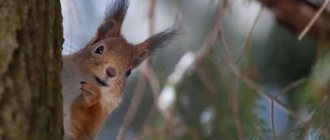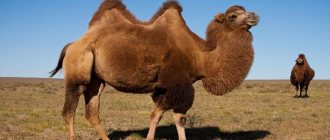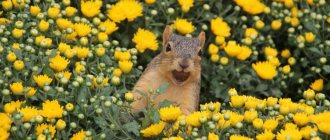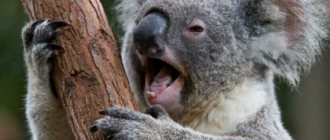Small furry animals that deftly jump from tree to tree are familiar to everyone. These are squirrels, animals belonging to the order of rodents. In nature, there are more than 50 species of these mammals, differing from each other in color, way and place of life.
If you look at the fur of a squirrel, it is not white at all, but red or gray, so it is impossible to say that the animal got its name because of the color of its skin. But there is a fact fully confirmed by sources that explains the appearance of the name.
Even in the times of Ancient Rus', squirrel fur was highly valued, and many merchants paid for goods with skins - “squirrels”. So the name was transferred to the animal itself.
The squirrel has long retained other names - mys, viveritsa, veksha. But this animal is now called extremely rarely.
Despite the fact that in those days there were sufficient numbers of squirrels in the forests, hunting them was not an easy task, and therefore squirrel skins (“whites”) were expensive.
Squirrel - description and appearance
There are about fifty species of representatives of the squirrel family, different from each other, but they certainly have common characteristics.
Torso, paws and head of a squirrel
All members of the family have an elongated body, usually thin, but with well-developed muscles, which allows the animal to easily jump from branch to branch and quickly move along tree trunks. The size of the body depends on the species, on average from 20 to 50 cm, and an adult weighs up to 1.5 kg.
The muscles of the paws are also well developed in squirrels, which is caused by the need for a strong push when jumping and a tenacious landing. Sometimes animals can jump quite a distance (especially if it is a downward jump), so strong legs ensure they land safely. Some species have special membranes between their front and hind legs that help them fly from branch to branch, sometimes covering quite long distances. All paws have toes with long and strong claws.
The squirrels have a small head, decorated with long ears with or without tassels.
Tail
Almost all members of the family have a gorgeous tail. But it's not just decoration. The tail serves as a kind of steering mechanism for the animal in flight; the animal hides with it when it sleeps. Females cover the cubs with their tail, especially in the first weeks, when the squirrels are still bald.
The state of health of an animal can be judged by its tail. As a rule, strong individuals have dense and fluffy hair on the tail.
The squirrels themselves are very attentive to the condition of their tail and always begin their toilet with it.
Squirrel fur
Squirrel pelts have always been prized for their dense fur. Representatives of the family boast a variety of colors: from light gray to dark brown shades.
If the areas where the squirrel lives are characterized by temperature changes, then the animals molt, usually changing not only the density of their hair, but also their color. Thus, by winter, squirrels living in Russia become gray-brown, and by summer they acquire a bright red color.
The density of fur among animals also varies. Contrary to popular belief, hairless squirrels are not found in the wild, and such a phenomenon is the result of a disease (for example, ticks). Such animals are doomed.
Squirrel's teeth
Depending on the species, squirrels have 20-24 teeth in their mouths. They begin to germinate at approximately one month of age (first the lower ones, then the upper ones).
Animals have to crack the shell and bite off hard pieces, so their teeth are well adapted to such food. Although the incisors are capable of wearing out and breaking, they grow throughout their lives, which allows the animal to eat solid food.
The animals also have molars, which they use to grind food. Unfortunately, they do not grow throughout their lives.
Rodents
Rodents, as the name itself shows, are animals characterized by the habit of gnawing. Indeed, they are easily distinguished from all other mammals by the structure of their dental system. It is they who have, in both the upper and lower jaws, a pair of very characteristic long, curved, chisel-shaped incisors that continue to grow throughout life; only in the family of hares we find, in addition to them, incisors of a different kind.
Due to the fact that rodents have no fangs at all, and the number of false molars in each jaw is always less than four, and sometimes drops to one, between the molars, on the one hand, and the incisors, on the other, a gap is formed in their dental system, along which each rodent can immediately be distinguished from all other mammals, with the exception of only one - the arm, which belongs to the prosimians and is characteristic of Madagascar.
Who gnaws all the nuts
Black squirrel
What treats!
Curious squirrel
Thanks for the bread - very tasty!
Squirrel gnaws nuts
Who is this?
Uninvited guest
I see and hear you
I sensed danger
The squirrel is enjoying itself
Squirrel on the road
The legs of rodents, which walk either on the entire foot or at least part of it, end mostly in five fingers armed with sharp claws, but sometimes with wide nails. The mouth of rodents is also distinguished by one feature that we do not find in any other mammals. The facial hair enters their oral cavity, extends posteriorly from the upper incisors and extends to the inner surface of the mouth, which is thereby divided into two cavities connected to each other by a relatively small opening. The front of these cavities contains the incisors, and the molars are located in the second.
Thanks to this arrangement of the mouth, it is difficult for splinters and other particles that occur when gnawing objects to enter the oral cavity itself. Most rodents wear a modest, often monochromatic outfit. However, some of them are brightly colored and have a beautiful design. We find spotted and longitudinally striped colors among them quite often, but a cross-striped pattern is apparently not characteristic of them at all. Likewise, they never have a tail decorated with alternating light and dark rings.
Of all living orders of mammals, rodents are the richest in representatives. The number of individuals of each species is very significant, and the distribution of most species around the globe is also wider than that of all other mammals. They are not found only in the Far North itself; with the exception of bats and the Australian dingo. These are the only representatives of higher mammals in Australia, which, as is known, is inhabited only by marsupials and monotremes.
South America is richer in them than all other parts of the world, and in it we meet the largest of the rodents. Almost all rodents are herbivorous animals and all process their food through incisors. All of them are timid animals, quickly disappearing when danger appears, but in extreme cases, some of them defend themselves against the enemy with desperate courage, inflicting relatively deep wounds on him with the help of their huge incisors. The fur of many rodents is used, but in most cases is not particularly valued; Among them, however, there are also those that deliver very valuable furs, and some play a large role in the fur trade due to the large number of individuals. The meat of only a few species is used for food, because in most it has a strong odor characteristic of rodents.
Where do squirrels live?
These funny animals have spread over many continents, with the exception of the desert regions of Africa, the polar regions of Eurasia, and Antarctica.
Squirrels are animals that live exclusively in trees: here they make shelters for themselves, breed their offspring, and find food, so in the places where the squirrel lives there must be tall vegetation. These can be coniferous, mixed and even tropical forests. The main thing is to have the opportunity to make a shelter for yourself.
In search of food, squirrels quite often come to cities, especially those located near forests.
These animals also feel great in city parks, where, without any fear, they take food from people’s hands. But it is very difficult to catch them - the animal reacts so sensitively to every movement that at the slightest danger it instantly hides in the crown of a tree.
Squirrels build shelter houses for themselves. Depending on the species, these can be nests made of branches, spherical or resembling bird nests; other squirrels prefer to live in a hollow, naturally formed or hollowed out by birds. Most often, an animal has several houses that serve different purposes. Somewhere she hides supplies, somewhere she breeds. The animal keeps the hollow clean, constantly throwing out garbage and feces, so you can find out which tree the animal lives on by looking at the piles of garbage on the ground.
Usually a squirrel in its hollow or nest lines the bottom with branches, moss, and feathers to make it warm and cozy. Before the cubs appear, she arranges a special place, adding her own fluff to it.
The most “fluffy” nicknames
Nicknames for squirrels are often chosen based on their wonderful fluffiness.
For boys:
- Yorshik
- Leshik
- Shaggy
- Dandelion
- Wig
- Pipidastr
- Bubble
- Pooh
- Pooh-Pooh
- Barber
- Sneeze-Puff
Little Ooh-Pooh's first photo shoot
For girls:
- Haze
- Kiki Morra
- Cosma
- Shaggy
- Mokhovushka
- Pukhaka
- Pushinka
- A gun
- Pumpkin
- Soufflé
Furcat waiting for a nut
What does a squirrel eat?
The diet of this animal directly depends on its habitat and species. Most squirrels prefer nuts, seeds of coniferous trees, acorns, and do not refuse mushrooms and fruits of wild plants. If there are fields near the forest, rodents will definitely feed on grains. In times of hunger, they can eat plant buds or young shoots.
The animals make provisions for the cold season. They arrange their storerooms in nests, hollows, or hang them on branches. Sometimes the forest squirrel buries its supplies, which greatly helps plant seeds to germinate.
In the tropical forests where the squirrel lives, the animal's diet may include tree fruits and flower nectar.
But these animals cannot be called completely herbivorous. Many of them eat insects and invertebrates, thereby replenishing the body’s supply of proteins. Squirrel tracks are often found near water bodies, where rodents sometimes even hunt frogs and lizards.
If you hand feed squirrels, it is better not to give them flour products and sweets. They are of little use, but they can cause harm to the animal.
Females feed their young with milk, so the question: “Is a squirrel a mammal or not?” disappears by itself.
Reproduction
These animals can breed up to three times a year. The mating season begins around February and ends approximately in March. At this time, males begin to behave especially aggressively. They attack their rivals in the fight for a female, and this is not surprising, because up to six males can fight for the attention of one female at once. The choice will still be up to the female; as a rule, she chooses the hardiest and strongest male.
The squirrel carries its cubs for about forty days; in the first days of pregnancy, it builds a birth nest where its babies will live. It is larger and warmer than the nest she usually builds.
There are no more than ten cubs in a litter, which, after their birth, are cared for exclusively by the female.
Baby squirrels are born blind and without fur, but after two weeks they are covered with fur, and after a month they begin to see. Two months after birth, the cubs become completely independent.
Types of squirrels
We are accustomed to the fact that a squirrel is a red or gray, nimble animal with a fluffy tail. In fact, there are more than 50 species of these mammals. Let's talk about the most prominent representatives.
Siberian common squirrel
Residents of Russia are accustomed to seeing a red-haired, nimble animal with a fluffy tail in parks and forests. This is a small animal, the length of its body is slightly more than 20 cm. It weighs about 300 g. A special decoration is its fluffy tail, the length of which is slightly less than the length of the body.
The forest squirrel builds its homes on the forks of branches, but more often it occupies tree hollows, which it carefully arranges, covering it with dry leaves, twigs, and moss.
In such a nest, the Siberian squirrel usually breeds its offspring twice a year. There are 3-4 baby squirrels in a litter. Babies are born bald, blind and deaf, and only by the age of one month do they become relatively independent. The mother feeds them with her milk for about two months, then the baby squirrels switch to adult food.
Squirrels are very caring mothers. If they find abandoned squirrel cubs in the forest, they are sure to take the babies for themselves.
Indian giant squirrel
The Indian squirrel is endemic to the Hindustan Peninsula. The animal received its name not by chance: its size differs significantly from many representatives of the class. The body length reaches 40 cm, and the tail of the animal reaches 60 cm. The weight of an adult can reach up to 2 kg. The animal is distinguished by its original coloring, combining three colors: the body is dark brown, brown-yellow, the legs and chest are of a lighter shade, and there are spots of a light shade on the tip of the tail and on the withers.
The Indian giant squirrel is diurnal; at night, these animals prefer to sleep in shelters located in the upper tier of trees. The places where the squirrel lives are predominantly moist mixed and evergreen forests. It is especially difficult for animals in dry times, when, due to a lack of greenery, their bright outfit becomes very noticeable to predators. What saves the animal is its ability to jump long distances: sometimes the length of the jump is 6 meters, and downwards - up to 10 meters. Not many people can boast of such abilities.
Animals feed on fruits, nuts, young shoots, plant seeds, mushrooms and lichens. They do not deny themselves the pleasure of eating some insects, as well as the eggs of small birds.
During the breeding season, these animals unite in pairs and build spherical nests, where they hatch cubs, which the mother feeds with milk for a little more than a month.
Despite the fact that the population is under state protection and special reserves have been created, experts believe that the number of animals is gradually approaching a critical level.
Australian squirrel
These squirrels are also called sugar flying squirrel, short-headed flying squirrel, sugar flying glider or pygmy flying squirrel. This small animal lives in the north and east of Australia, New Guinea, and Tasmania.
This small-sized mammal weighs a maximum of 140 g, and the body length is no more than 18 cm, but the tail can be up to 20 cm. The animal’s body is very thin, there are membranes on the sides that help it fly from tree to tree. In flight, the animal can cover a distance of up to 50 meters.
The flying squirrel is nocturnal. Huge eyes are adapted for hunting in the dark. The animal has large ears, which help it hear even barely audible sounds. The animal's gray skin with minor dark spots and a lighter shade of the belly make it almost invisible on tree trunks.
Due to its rather secretive lifestyle, it was difficult to find out what this squirrel eats in nature, but researchers have found that in cold weather the flying squirrel prefers plant juice, especially eucalyptus and acacia trees, nectar and fruits. If the temperature rises and there are more insects, animals prefer protein foods: insects, small invertebrates. If there is not enough food, the animals fall into a state close to hibernation. Having taken refuge in nests, they sleep almost the whole day.
The Australian sugar squirrel is a social animal. They unite in families, the head of which is the male. Usually in such families there are 7-8 males, the number of females and young animals can be very large.
Gray squirrel
Several species of North American rodents are called gray squirrels:
- Arizona;
- western gray;
- Carolina (eastern gray);
- Mexican gray
These animals received their general name for the color of their coat: from gray to dark gray, gray-black. As a rule, there are red tan marks on the head, paws and tail. The gray squirrel lives in coniferous, mixed and broadleaf forests; Arizona squirrels can be found in high mountain areas, even at an altitude of more than 1500 meters above sea level.
The gray squirrel has the following dimensions: its body reaches 45-50 cm in an adult, its tail length is 30 cm.
Usually the animal eats acorns and walnuts, which are their favorite food. He does not refuse anything he finds in the forest: pine nuts, mushrooms and berries.
They usually give birth to cubs twice a year. There can be up to four babies in a litter. The mother feeds them milk for one and a half months. By this time, naked from birth, the babies become covered with fur, try adult food, learn to climb from branch to branch and even jump.
Black squirrel
The habitat of this beauty is the eastern regions of the United States, Canada, and Mexico. It was also found in the Altai Territory.
A distinctive feature of this animal is, first of all, its unusual color. Its fur on the back and legs is black-brown, brown-gray or brown-yellow, but the chest and belly are light in color, which contrasts very much with the rest of the color. Some species have longitudinal light stripes across the tail and head, which makes the animal very beautiful. Unlike many of its relatives, the black squirrel is quite large in size. The body of an adult can be up to 70 cm in length, while the tail can be up to 35 cm (in many, the tail is longer than the body). Some animals can weigh about 1 kg.
In the forests where the squirrel lives, there is a lot of varied food, which makes up the animal’s diet. These are nuts, buds and flowers of trees, red maple seeds, and sometimes animals destroy bird nests. In the summer, they enjoy berries and mushrooms, eat insects, and visit fields where they eat cereals and legumes.
Representatives of this species spend a lot of time on the ground, although they also move well in trees, clinging to the trunk and branches with sharp claws of their fingers.
If in captivity these animals can live up to 18 years, then it is quite difficult to find out how long a squirrel lives in its natural environment. As a rule, many animals die from predators and poachers before they even reach adulthood.
Black squirrels become sexually mature closer to the age of one year. Most often, there are 3-4 cubs in a litter, which remain blind and deaf for quite a long time. Unlike babies of other species, they feed on mother's milk for about three months and hide in a shelter.
Nursing the Cubs
After several weeks of pregnancy, the female lays three to nine initially blind cubs, which she transfers to another nest if her offspring are disturbed.
Mating time lasts from late February to April and is accompanied by fierce battles between males and each other. A squirrel caught from a young age easily becomes tame and gets used to its owner - in captivity it is willingly kept for its lively, active disposition.
For offspring, the female builds a separate nest, usually several of them. This is necessary to transfer your children to another place in case of danger. The gestation process takes 35-38 days, 1-10 cubs are born.
During this period it is still cold, so the nest is well insulated; the temperature inside is about +20 degrees, while the outside temperature is 0° C.
Cubs
Most often there are 3-4 cubs, they have no hair, pink skin, each weighs about 8-12 grams. Newborns are poorly developed and blind. The fur coat begins to appear 10-13 days later, by 20 days after birth the skin is completely covered with fur.
Until they reach 1 month, the eyes remain closed, and after 15 days the female can stop feeding the squirrels with her milk. During this period, they begin to eat solid food on their own and explore the nest. Feeding with milk may be longer if there is not enough food. After about 8-10 weeks, the baby squirrels leave the nest and go in search of their territory. They reach sexual maturity a year later.
Red-haired beauty squirrel
Who's calling me there?
Squirrel on a branch
Squirrel on the Christmas tree
Squirrel on the road
Or is it better to climb this way?
What an interesting mushroom there looks out there
Little squirrel
In autumn the squirrel is not visible among the leaves
So many goodies!
A squirrel can climb on any branch
But now I’ll get this bump
Squirrel at home
Recently, squirrels are increasingly being kept as pets. Their care and maintenance do not bring much trouble to the owners, but, as with any animal, it is necessary to take into account all the natural characteristics of these animals. Only then will they feel comfortable. The most popular among the representatives of the class is the degu squirrel. Easy care and easy maintenance make her a favorite pet for many.
Before buying an animal, they ask whether a degu squirrel can exist in a cage and how many years it lives in captivity. With good care they can live up to 10 years.
As already noted, degu squirrels are usually purchased as a pet. At home, this animal can exist perfectly well. This animal is not so expensive, from 1 to 3 thousand rubles, depending on gender and age. You can find out exactly how much a degu protein will cost in a nursery or store on ad sites or from breeders.
A pet degu squirrel will do better if it has a mate. You can also have several individuals of different sexes, then they will not be bored. The Chilean degu squirrel is a very social animal that needs constant communication with its relatives. If it is not possible to have several individuals, constantly communicate with her yourself. Degu is a squirrel that can run wild and become aggressive due to loneliness.
Nicknames for toys
The toy industry offers a huge selection of toy squirrels. They need names too. But, naturally, it’s a little simpler - after all, children will name their favorites. You can only give them an idea, then they will somehow do it themselves...
- Belik
- Bryska
- Wasabi
- Vyusha
- Julia
- Angry
- Knopa
- Chit
- Shaggy
- Donut
- Jump
- Puzik
- Bullet
- Puska
- Fluffy
- Ryzhulya
- Jump
- Sonya
- Typhoon
- Tikhon
- Quiet
- Tishka
- Coward
- Sheila
- Shustrik
- Nimble
Squirrel Skok - a favorite toy since childhood
What should a house for a squirrel look like?
The degu is a squirrel that, like many of its brethren, loves space, so the cage must be large enough.
Even very small baby squirrels are strictly prohibited from being kept in glass jars. A degu living at home can die from this protein. Care and maintenance should be as close as possible to the natural environment.
If your pet is a Chilean degu squirrel, pay attention to the equipment of its home. The bars of the cage should be iron, since the degu squirrel at home does not forget about its natural ability to gnaw and will easily make a loophole for itself.
Equip the cage with branches so that the degu squirrel at home can constantly climb and jump; be sure to give it several different shelter-houses.
Most animals of this family do not like drafts; if their house is in a cold or drafty place, they can get sick.
The Chilean squirrel is quite curious. Care and maintenance must take into account this feature of the animal. Sometimes place objects in her house that she can examine.
Feeding squirrels at home
Feeding squirrels at home should be as close as possible to that of their counterparts in the wild. It is preferable to give to animals:
- nuts (you can even have shells);
- hard vegetables and fruits;
- corn;
- protein food (worms, larvae);
- chalk and eggshells;
- fresh or dried mushrooms;
- tree catkins, buds;
- sunflower seeds.
Some species eat quite a lot of sweet fruits in their natural environment (Australian squirrel). If there is a lack of sugar, the animal may get sick.
Don't forget about water. There must be small bowls of clean water in the animal's cage. Giving juices, nectars and milk is not worth it.
If the squirrel in the house begins to gain weight, you need to either give it sweets less often or give it the opportunity to move more. Unfortunately, these animals can also become obese.
A degu squirrel at home can eat from its owner's hands if it is accustomed to this. With the help of food, you can lure the animal into the house if you allow it to walk around the apartment.
